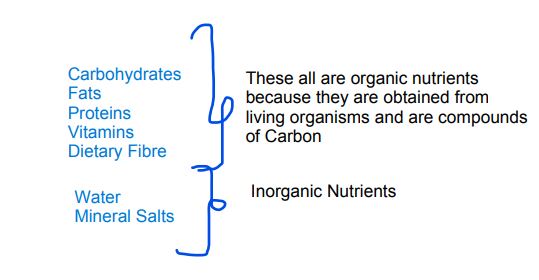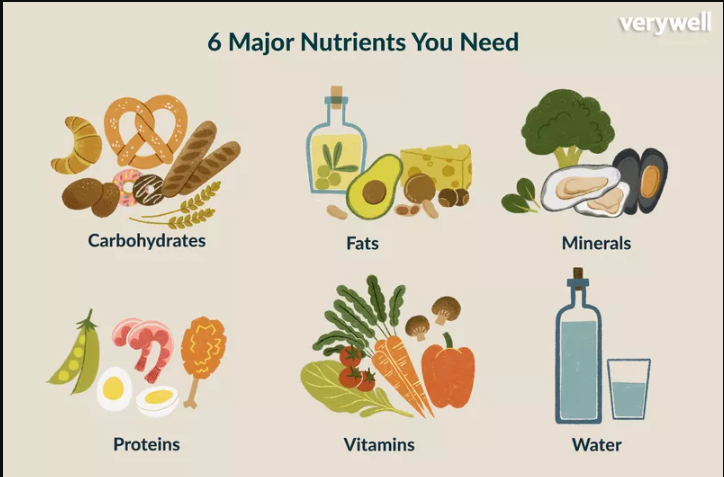Chapter 5: Nutrition
Why do we need food?
- To ^^provide energy^^ for the vital activities of the body.
- To ^^synthesize new protoplasm.^^ i.e for growth and repair of worn out parts of the body.
- To ^^maintain health and prevent deficiency.^^
Nutrition:
Are the chemical substances in food which nourish the body and provide energy.

Carbohydrates:
Are ^^organic compounds^^ made up of the elements made up of the elements carbon, hydrogen and oxygen. Carbohydrates are classified as Monosaccharides, Disaccharides and Polysaccharides.
Monosaccharides:
- Simple sugars.
- e.g. glucose, fructose and galactose.
Disaccharides:
- Complex sugars.
- Made up of two molecules of simple sugars condensed together.
- e.g Sucrose, Lactose and Maltose.
Condensation Reaction: is a chemical reaction whereby two simple molecules are joined together to form a larger molecule with the removal of one molecule of water.
Polysaccharides:
- Made up of many monosaccharides joined together by polymerization.
- e.g Starch, Glycogen and Cellulose.
- Starch and Cellulose are insoluble in water.
Polymerization: is the process of condensing many similar molecules to form a large molecule.
Functions of Carbohydrates:
- Source of energy.
- Helps in forming a supportive structure eg. cellulose cell walls in plant cells.
- Formation of nucleic acid.
- Helps in synthesizing lubricants eg. mucus which consists carbohydrates and a protein. (This lining in the respiratory system traps dust particles.
- To produce nectar in some plants.
Fats:
Are ^^organic compounds^^ made up of the elements carbon, hydrogen and oxygen but, ^^unlike carbohydrates, they contain much less oxygen in proportion to hydrogen.^^
- When fats and water are catalysed they produce glycerol and fatty acids (hydrolysis).
Hydrolysis: is the reaction whereby a water molecule is added to split up a complex molecule into smaller molecules.
Functions of Fats:
- Storage form of energy.
- Insulating material beneath the skin to prevent heat loss.
- As a solvent for fat soluble vitamins and many other vital substances such as hormones.
- As a constituent of protoplasm.
- As a means to restrict water loss from the surface of the skin.
Sources of Fats:
- Butter
- Cheese
- Fatty meat (most fish and white meats are relatively fat free)
- Olives
- Nuts and seeds of castor oil, palm oil.
NOTE: The type of fats occuring in animal bodies are called ^^Saturated Fats^^. Usually found together with saturated fats is a fatty substance called Cholesterol. Vegetable fats are unsaturated fats. They are not harmful and should substitute saturated fats in a diet.
(Cholesterol: is a waxy type of fat, or lipid which moves throughout the human body through blood. If it gets deposited on the inside of arteries it may cause heart attack).
Proteins:
Are ^^complex organic substances^^ containing carbon, hydrogen, oxygen and nitrogen. Rarely sulphur and phosphorous.
- They are present in protoplasm.
- Every molecule is built up from ^^simpler compounds known as amino acids^^. If three or ^^more amino acids are linked up by peptide bonds a polypeptide or peptone^^. A protein is made up of one or more such chains.
NOTE: Protein molecules are very large, they cannot pass through living membranes, so the proteins which are ingested cannot be absorbed directly into the body of the animal. They are broken down by enzyme protease.
Effects of protein deficiency:
kwashiorkor
Sources of Protein:
- meat
- fish
- eggs
- dairy foods
- vegetable and nuts
Functions of protein:
- Essential for the synthesis of protoplasm.
- For growth and repair of worn out body cells.
- For synthesis of enzymes and hormones.
- For formation of antibodies to combat disease.
- A source of energy.
Vitamins
Are a ^^group of chemically unrelated organic compounds required in the diet of humans in minute amounts.^^
- Many vitamins are o^^btained from plant foods but some may be obtained from tissues of other animals.^^
| Vitamins | Sources | Functions |
|---|---|---|
| D - fat soluble vitamin | fish liver oils + ultra violet rays from sunlight | promotes absorption of calcium and phosphorous compounds + formation of teeth and bone. |
| C (ascorbic acid) - water soluble | fresh citrus + vegetables + fresh juices (not artificial) | needed for the formation of intercellular substances + for maintaining healthy epithelial tissues. |
| A | dairy products + fish liver oils and green leafy vegetables | for formation of retina. |
| B - Complex | yeast, liver and bran | maintaining energy levels and cell metabolism. |
Minerals:
Are ^^inorganic salts which do not provide energy but are indispensable to bodily functions.^^
| Inorganic Elements: | Sources: | Functions: |
|---|---|---|
| Calcium | milk + cheese + eggs | for building of bones and teeth + for muscle functioning + clotting of blood. |
| Iron | liver + red meat + egg yolk + dark green vegetables | formation of haemoglobin + certain enzyme involved cellular activities. |
Water:
Is extremely important as it is the ^^essential constituent of protoplasm.^^
Functions of Water:
Medium at which certain chemical reactions take place.
Essential lubricant found in joints + digestive juices + blood.
Transporting agent for digested food substances from intestines to other parts of the body + excretory products from tissue cells to excretory organs for removal.
